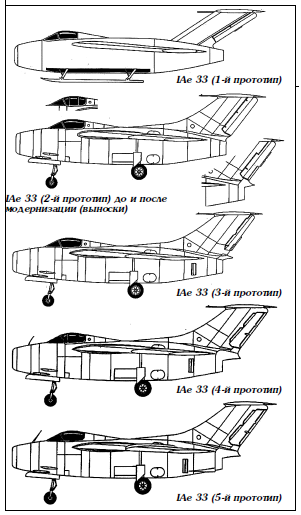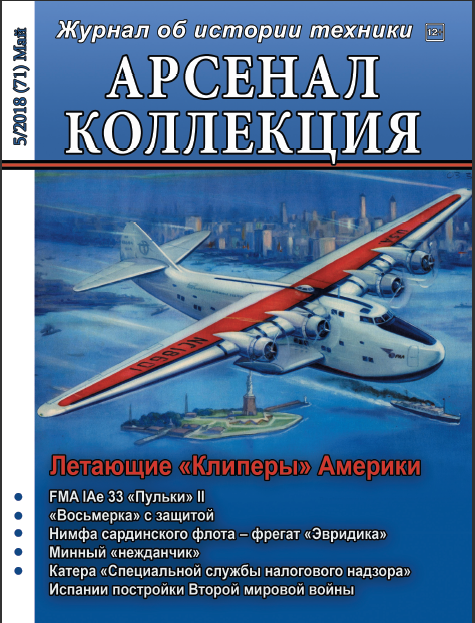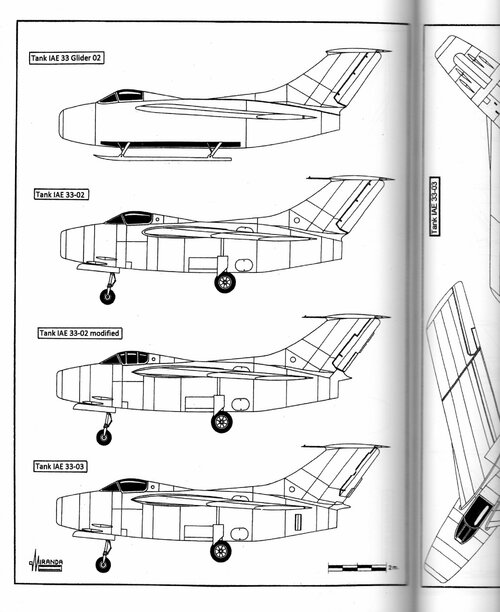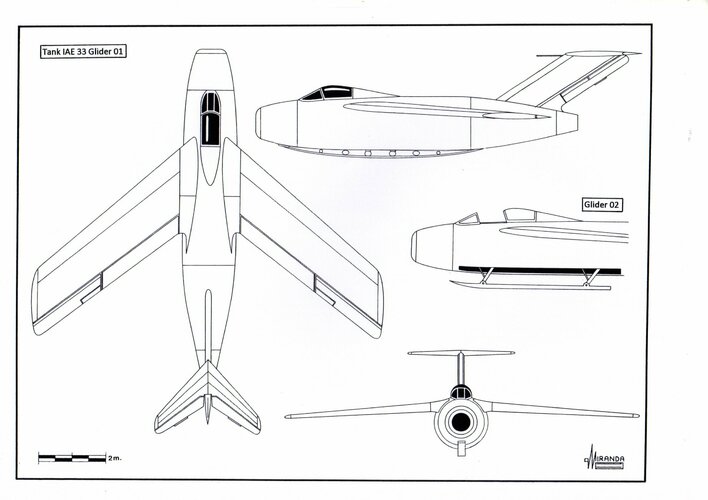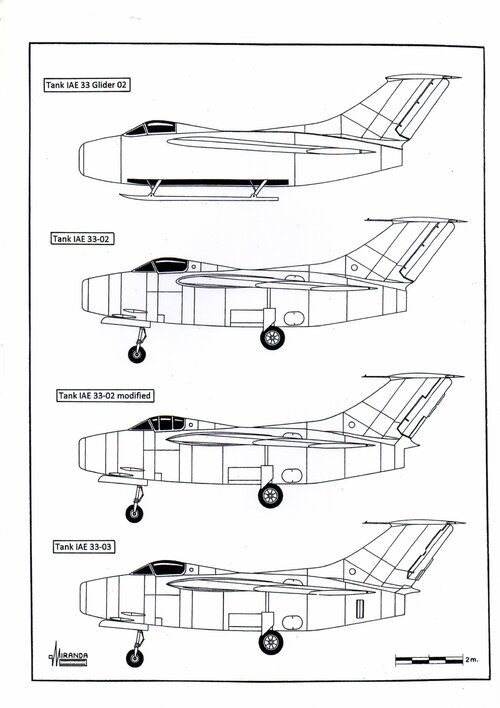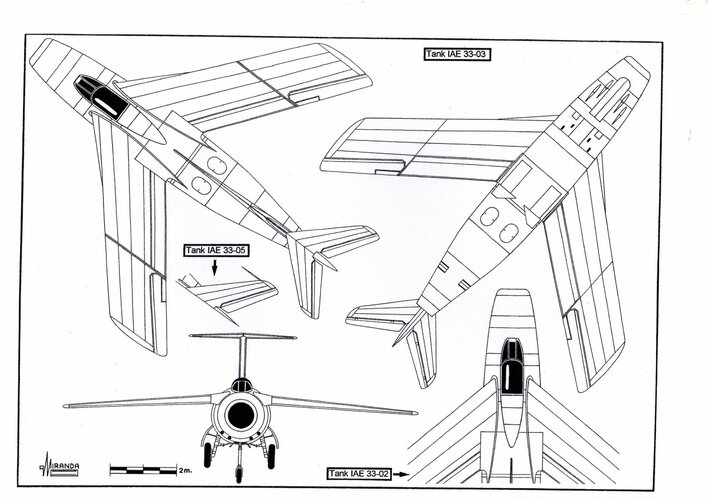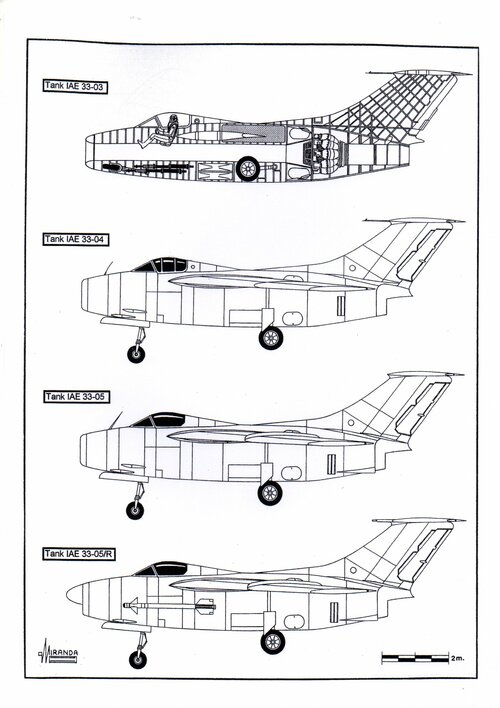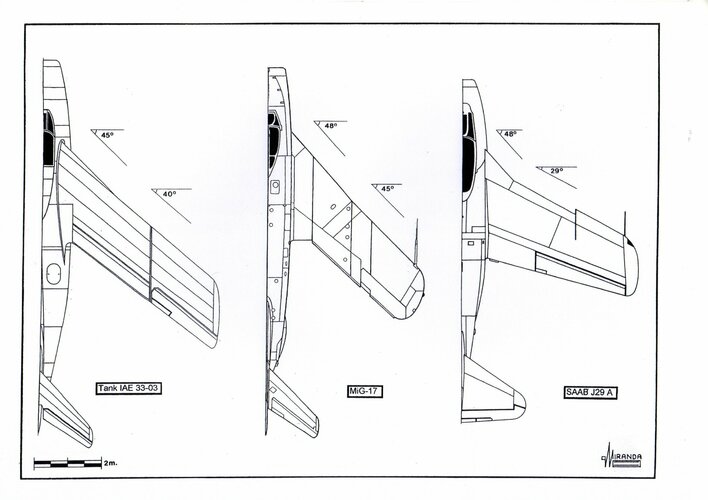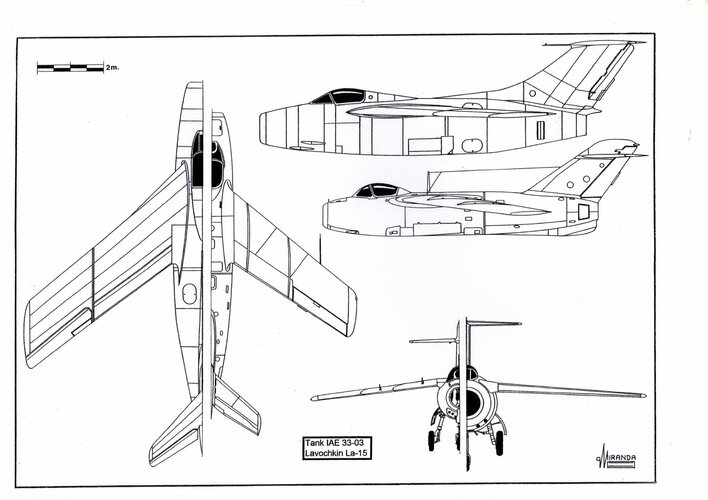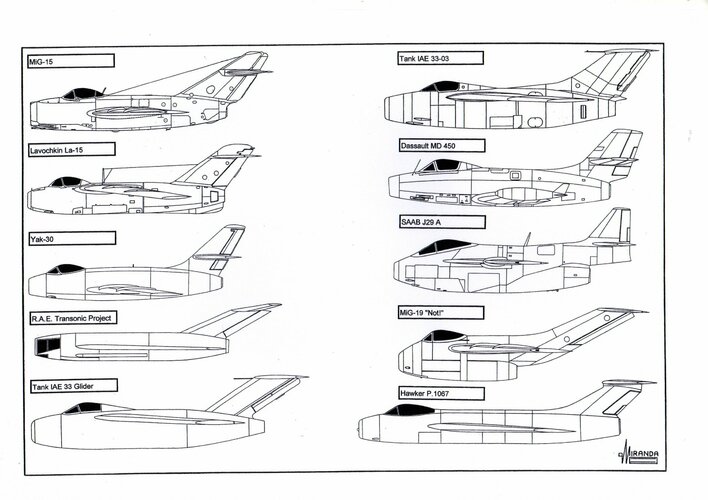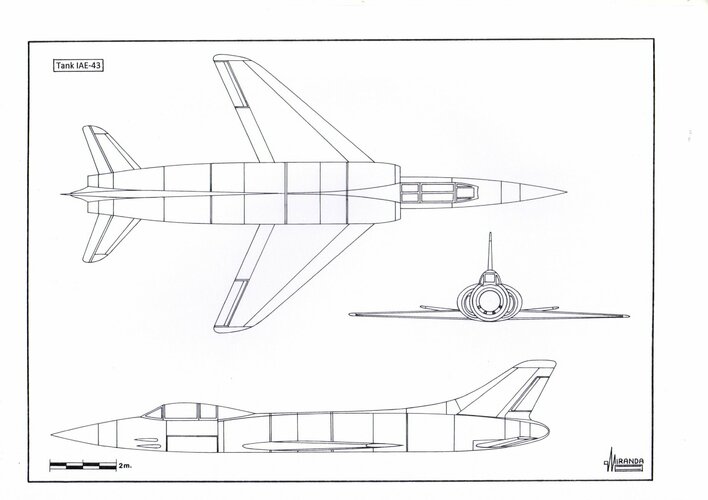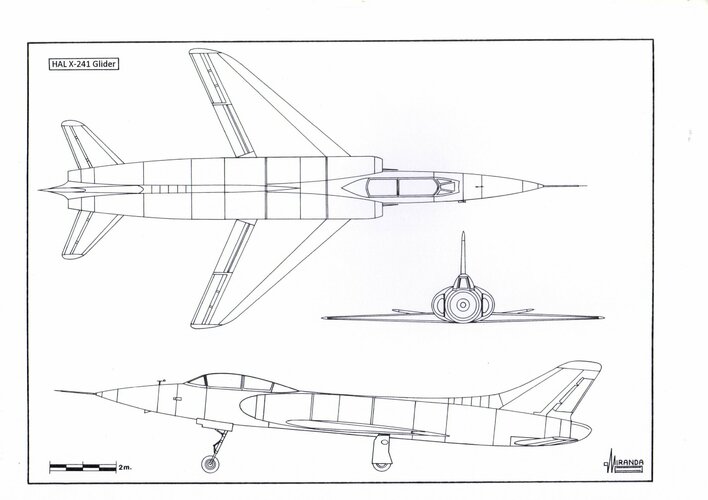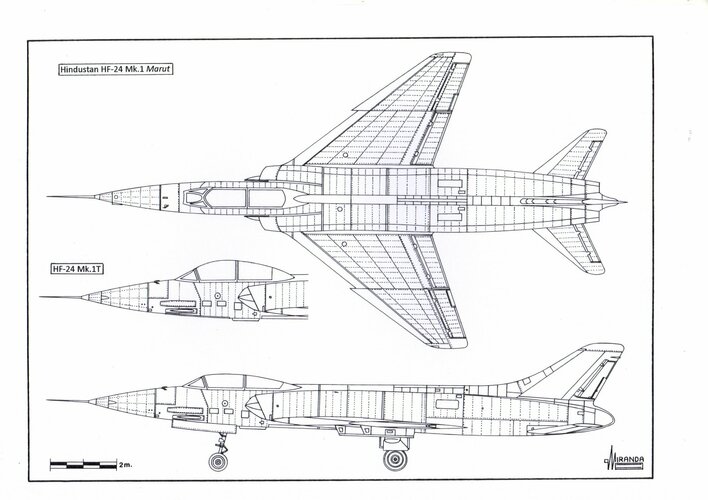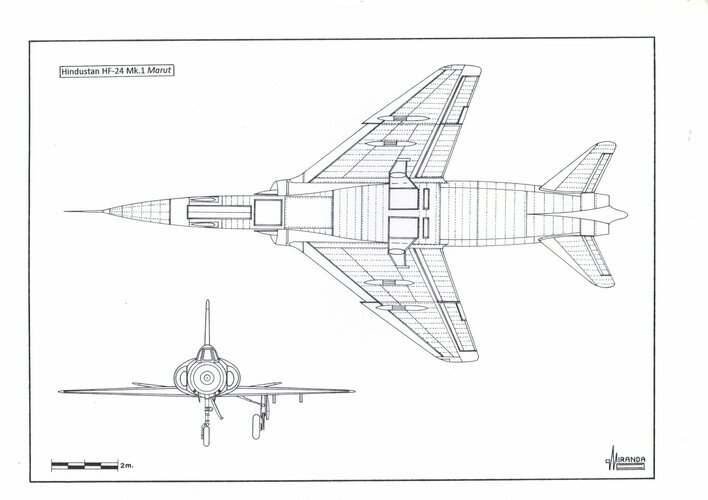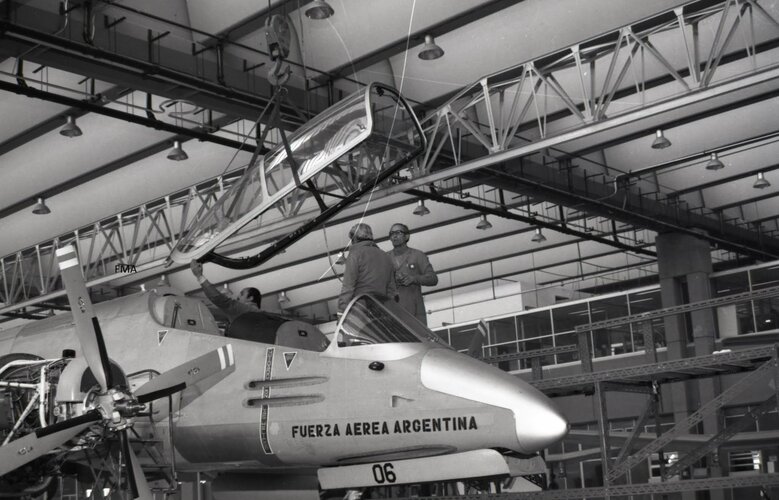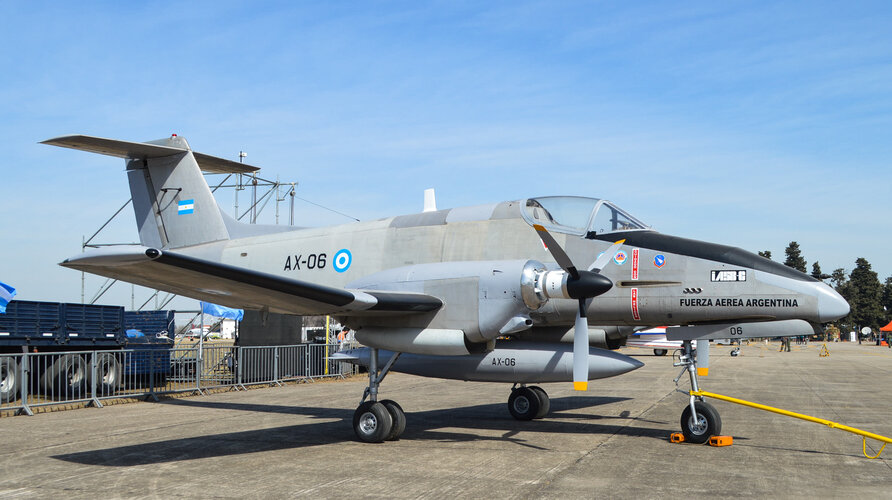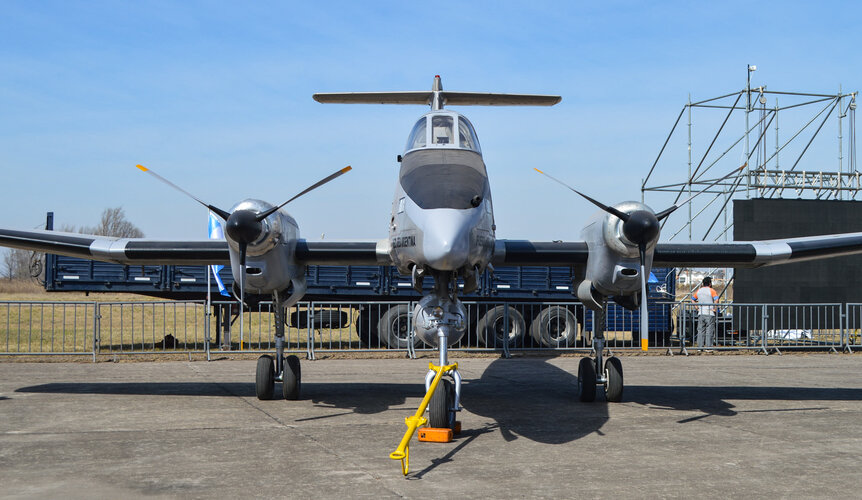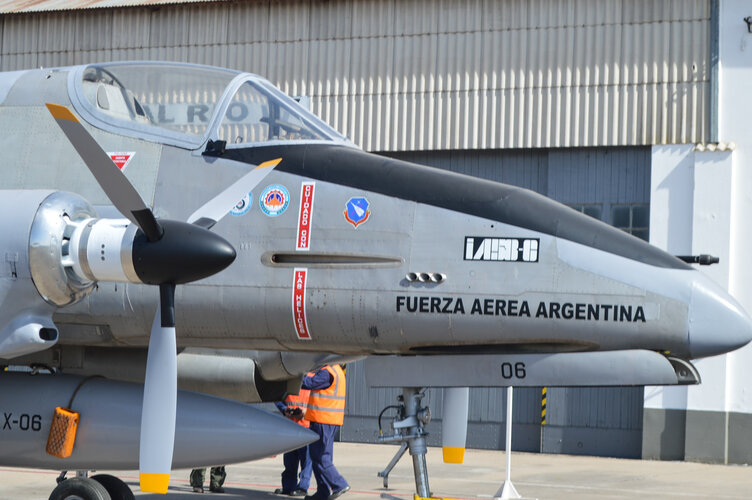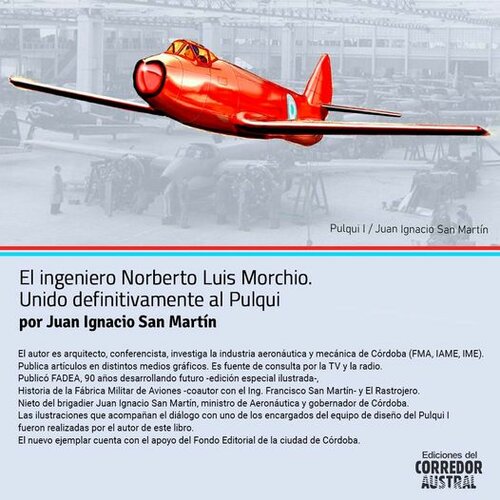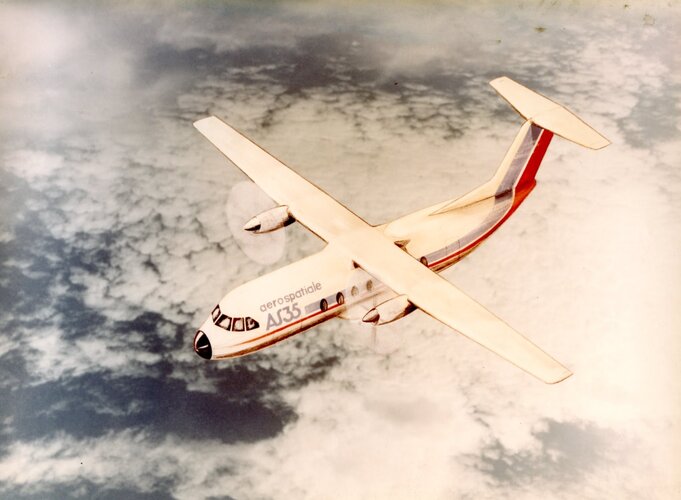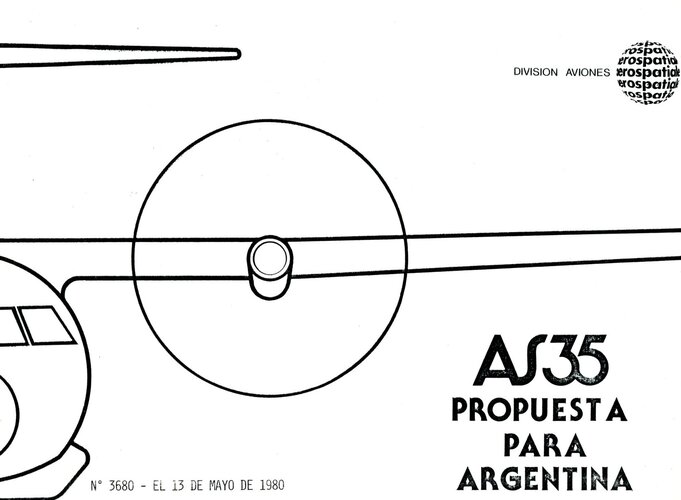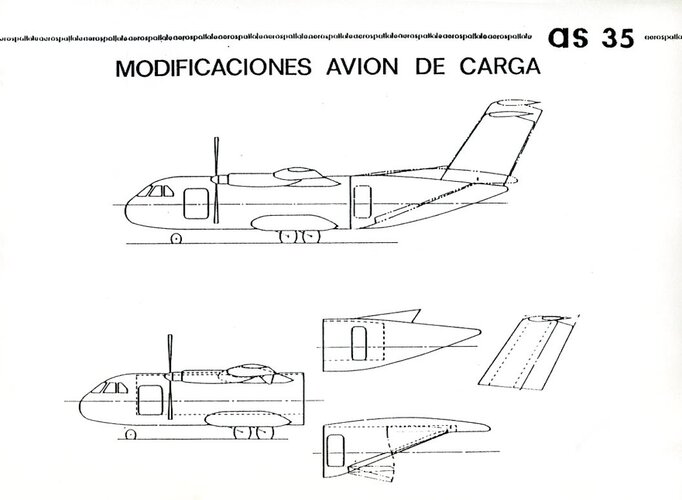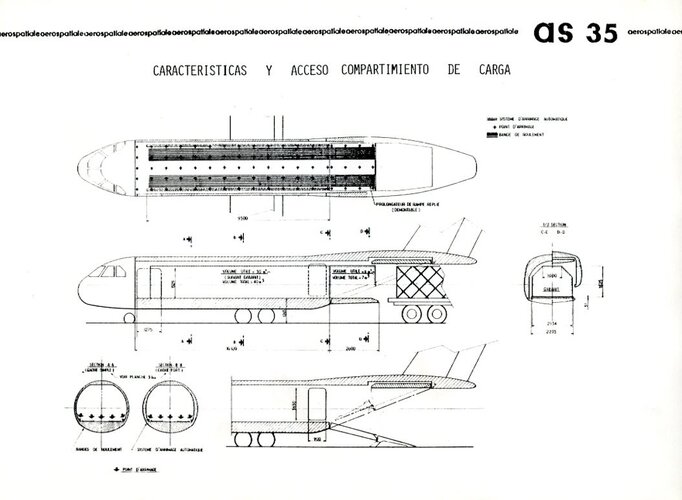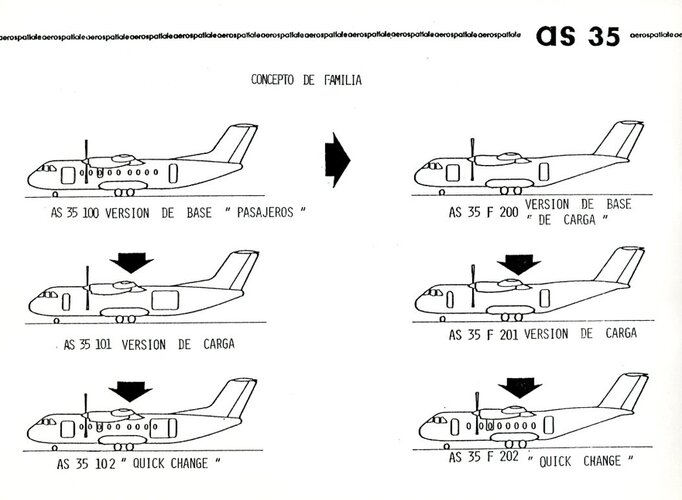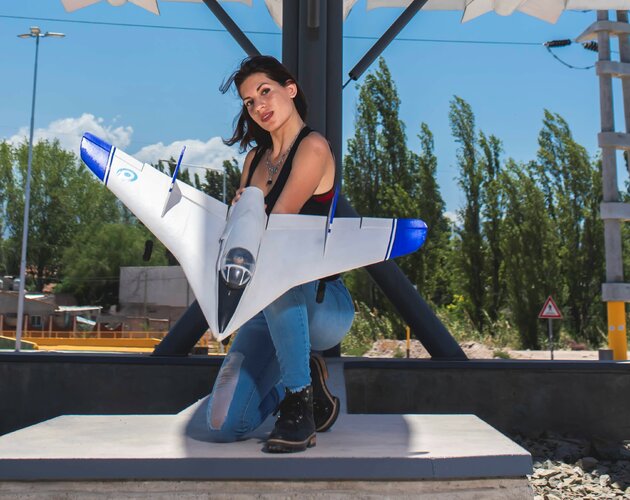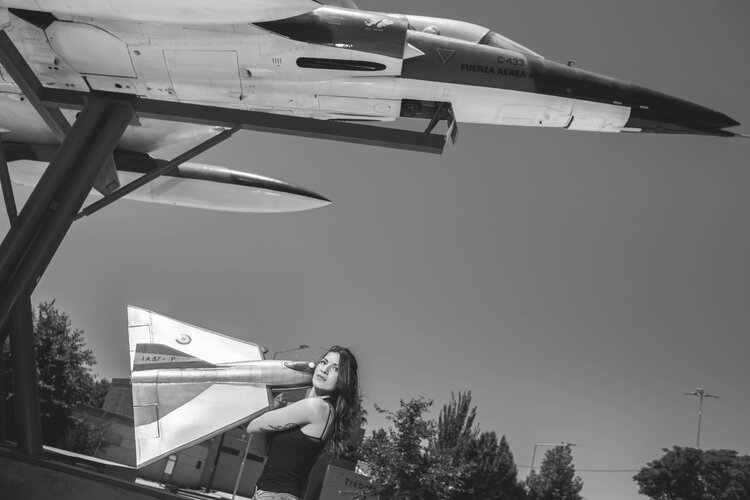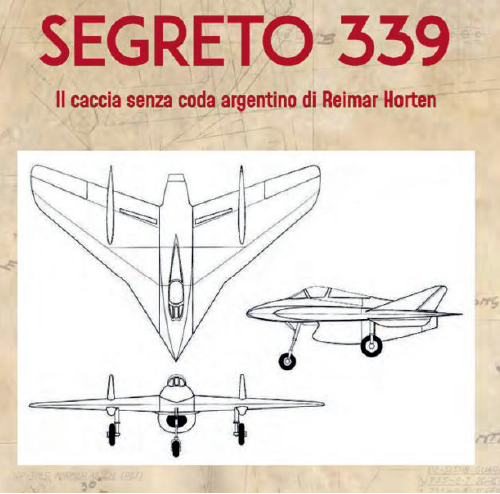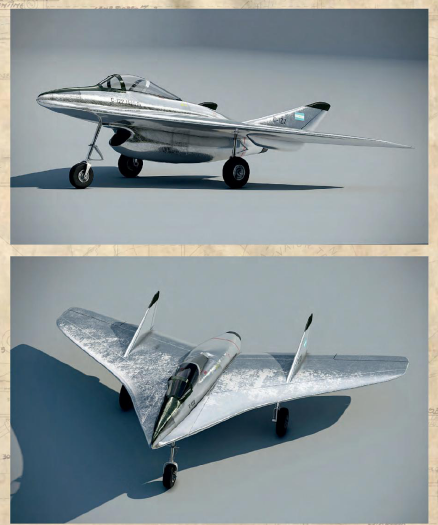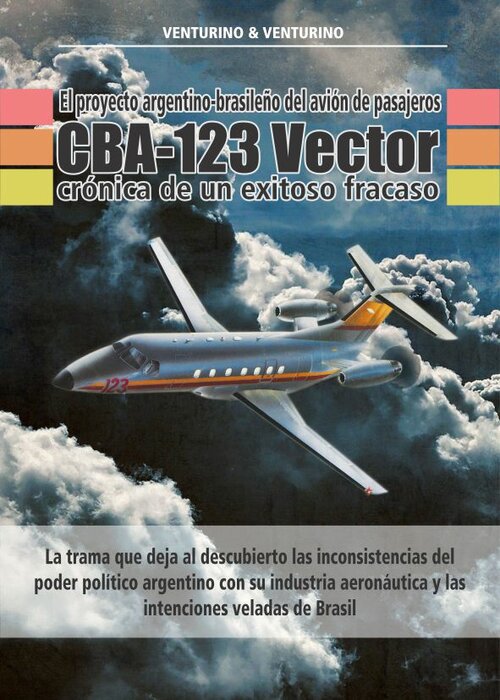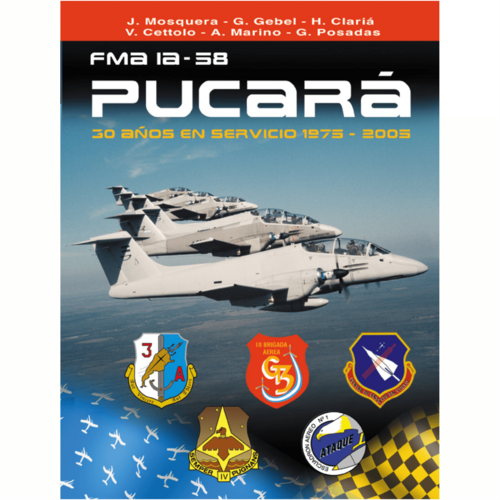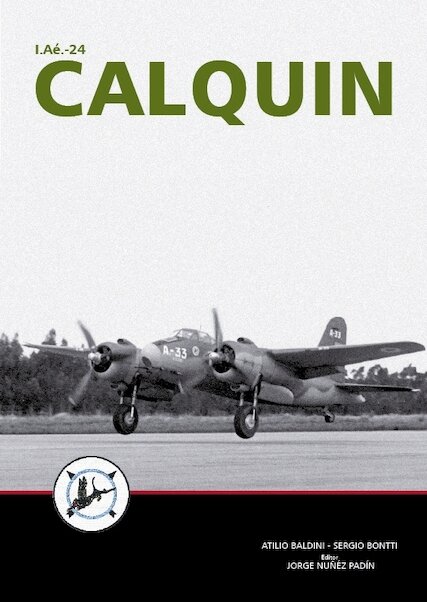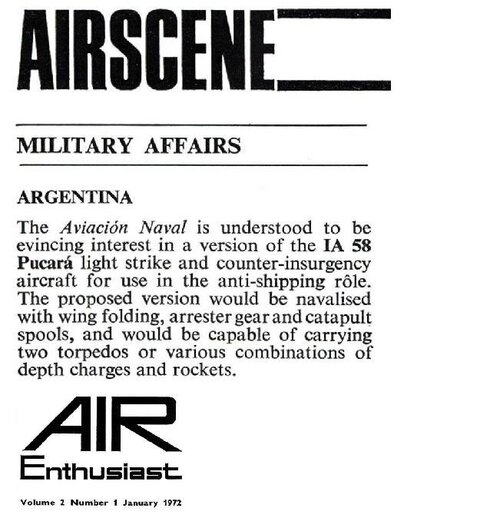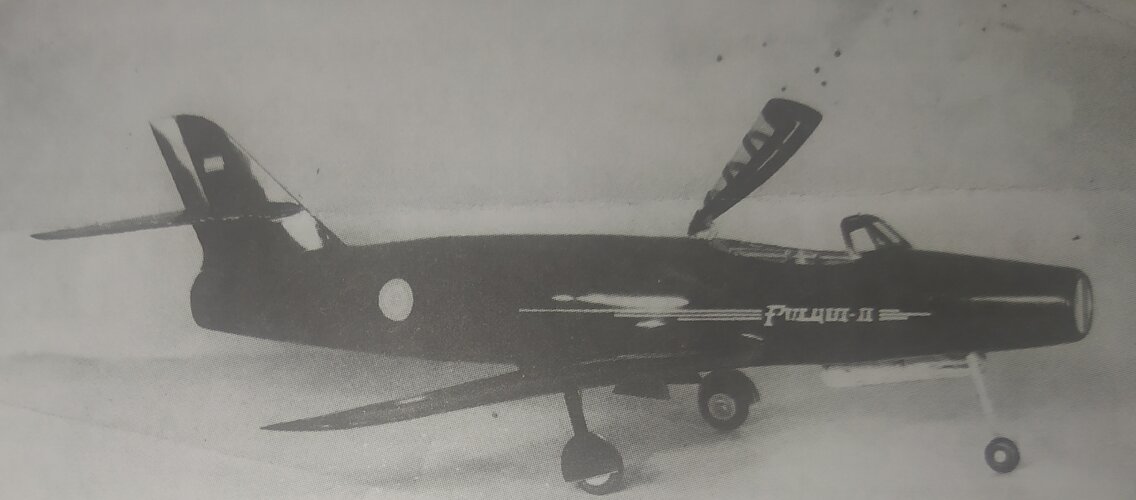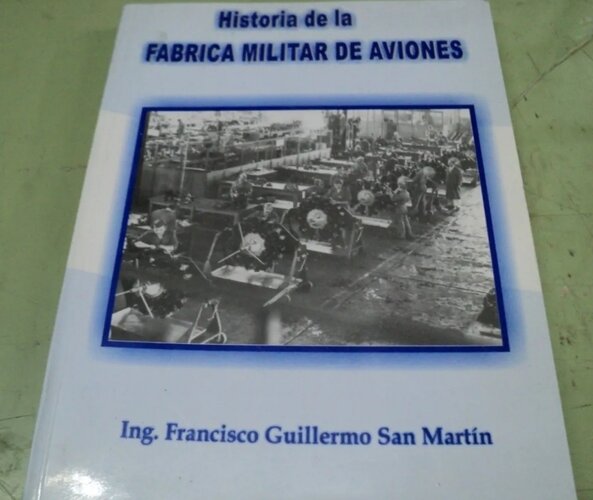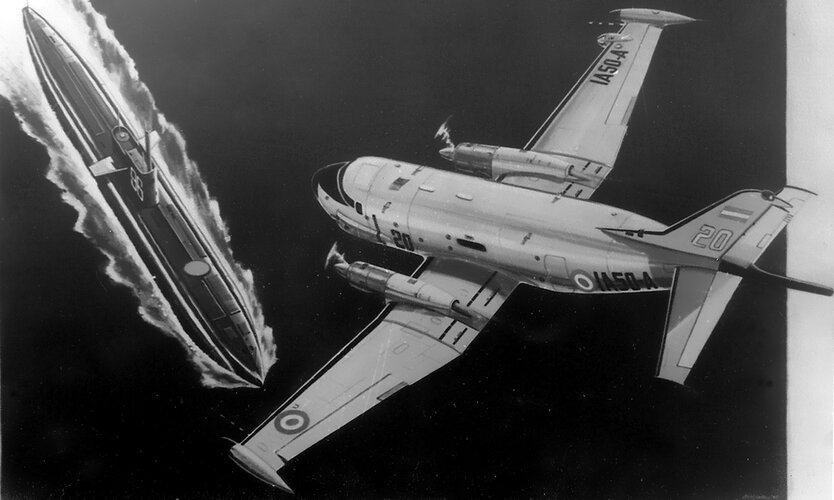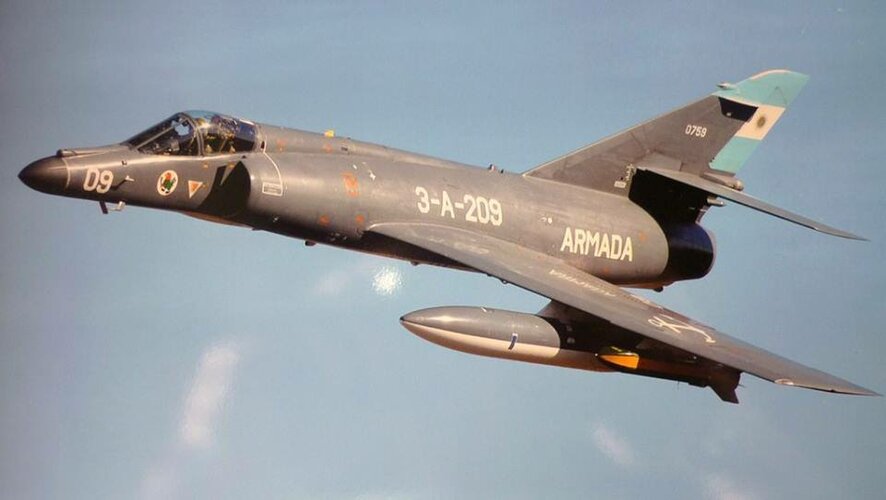You are using an out of date browser. It may not display this or other websites correctly.
You should upgrade or use an alternative browser.
You should upgrade or use an alternative browser.
Argentinian Unbuilt Projects
- Thread starter raravia
- Start date
Miranda drawingsFrom that source.
Attachments
Tank IAE 33
Developed by Kurt Tank in Argentina between 1947 and 1955, the IAE 33 was a transonic interceptor derived from the Focke-Wulf Ta 183. Two test gliders and five prototypes were built of this aircraft. The scheduled production of 100 operational units was cancelled for political reasons in 1957.
The first glider was built with the collaboration of Reimar Horten in early 1948, to study the aerodynamic behaviour of the design at low speeds. It fled for the first time on 20 October, towed by a Glenn Martin W-139 bomber, proving that the 55 degrees swept tailfin did not offer sufficient lateral stability. The second glider was built with a 35 degrees swept tailfin, which surface had been increased by 30 per cent.
The construction of two prototypes started in 1949. The IAE 33-01 was used for structural testing and the IAE 33-02 was fitted with a Rolls Royce Nene II centrifugal turbojet with 2,270 kp static thrust. The first flight was made on 16 June 1950 showing lateral instability at speeds above 700 kph and loss of lift at low speeds. It was modified with the installation of a wider rudder and wing leading extensions, a pressurizing system and a cockpit hood reinforced with metallic strips. A deflector was added over the nozzle to protect the rudder from the heat of the exhaust gases.
On 23 October, during the second test flight, the IAE 33-02 climbed to 8,000 m in 6 minutes reaching a speed of 1,040 kph. During the third flight, it reached an absolute ceiling of 13,000 m, landing at 170 kph without loss of lift. It was destroyed due to wing structural fail on 31 May 1951.
The IAE 33-03 was the preproduction version. It had an increased fuel capacity and better lateral stability, resulting from the installation of a new flight control system. Its flight testing began at the end of 1951, getting destroyed due to an engine stoppage on 9 October 1952.
The IAE 33-04, built in 1953, was equipped with four hydraulic operated airbrakes on the rear section of the fuselage and fences on the upper side of the wings, to delay the migration of the centre of pressure at transonic speeds. It had an improved pressurized system and was armed with four Hispano-Suiza Mk.5 cannons of 20 mm installed under the air duct. During the flight tests performed in 1954, the 04 reached an absolute ceiling of 15,000 m and 1,080 kph maximum speed.
The IAE 33-05 was started in 1957, without fences but with four anti-spin fins in the rear section of the fuselage, flying for the first time on 18 September 1955 and the last in 1960. The IAE 33 airframe was built entirely of light alloy. The wings, spanning 10.6 m, with 40/45 degrees rear swept angle and 8 per cent thickness, housed two fuel tanks with 150 litres of capacity each, two with 154 litres, two with 170 litres and two with 160 litres, as well as the ailerons and the hydraulically operated flaps.
The fuselage housed the pressurised cockpit, with armoured windshield, the Mk.IIc gyro-gunsight from a Gloster Meteor F.Mk.4, and Martin-Baker Mk.1 ejector seat, the armament, the landing gear, the air intake with bifurcated air duct, three fuel tanks with 656, 485 and 156 litres of capacity, the engine pressure compensation chamber, the turbojet, the tailpipe, four airbrakes ant the 35 degrees rear swept tailfin.
The tailplane, with 45 degrees rear swept, was fitted with an electric motor to vary its incidence. Both the Dutch and Egyptian governments were interested in the acquisition of the IAE 33. An all-weather version with radar, two Sidewinder missiles and a Rolls Royce AJ65 Avon turbojet was also planned. It would have been a good competitor to the Sabre K. The coup of 16 September 1955 ended production plans. Instead, the new government acquired 28 units of the North American F-86 F-30/40 Sabre.
Attachments
Tank IAE 43
When the firm Bristol Siddeley published the features of its new turbojet Orpheus in early 1954, a team of German designers integrated by Kurt Tank, Wilhelm Basemir and Ludwig Mittelhuber began to work in the project of an all-weather supersonic fighter, called IAE 43, in Argentina.
The fuselage would be built of light alloy, housing the radar parabolic mirror, four Hispano-Suiza Mk.5 20 mm cannons, the nose undercarriage leg and the cockpit (pressurised at 0.25 Kg/sq cm). It had a Martin-Baker ejector seat and armoured glass windshield, a space designed to house a second crew member or a fuel tank, two airbrakes, two fuel tanks, the main undercarriage wheels, two semi-circular air intakes, two air ducts, two Bristol Siddeley Orpheus BOr.1 with 14.61 kN static thrust each, the tailfin and the tailplanes with 50 degrees rear swept, low set to minimize any tendency to pitch-up.
The wings, spanning 9 meters, with 50 degrees rear swept, 6 per cent thickness/chord ratio and 25 sq. m area, would be built of steel and Dural. Each wing panel housed one fuel tank and hydraulically operated flaps and landing gear retraction system. The development of the IAE 43 in Argentina was interrupted in September 1955 for political reasons, being continued in India as HAL HF-24 Marut.
Attachments
- Joined
- 6 September 2006
- Messages
- 4,829
- Reaction score
- 9,424
I have always been interested to know whether there were any major changes between the IAe 43 and the HF-24.
Did India essentially buy a completed design? India planned to fit its own engines etc. but I assume essentially the design was completed by the time India took on Tank's work.
Did India essentially buy a completed design? India planned to fit its own engines etc. but I assume essentially the design was completed by the time India took on Tank's work.
I have always been interested to know whether there were any major changes between the IAe 43 and the HF-24.
Did India essentially buy a completed design? India planned to fit its own engines etc. but I assume essentially the design was completed by the time India took on Tank's work.
- Hindustan HF-24 Marut
In the years following Second World War many countries were forced to modernize their Air Force by acquiring the new technology of the turbojet to the winning powers. Those who chose to use the export versions of the Gloster Meteor regretted their decision when the performances of the new Soviet fighters were known. Dutch and Egyptians, interested in the work carried out by Kurt Tank's team in Argentina, began negotiations for the acquisition of the IAE 43.
In 1955 the pursuit of self-reliance in aviation by the Indian Government led the Air Staff to issue a requirement calling for a home-made multi-role aircraft suitable for both high-altitude Mach 2.0 interception with a ceiling of 60,000 ft. and low-level ground attack, with a combat radius of 800 km. Furthermore, the specification demanded that the basic design be suitable for advanced trainer, all weather interceptor and shipboard versions.
The Air Staff overestimated the complexity of the task. The local aircraft builder Hindustan Aircraft Ltd. (HAL) had been building Vampire F.B. 52 and T.55 under license but its only autochthonous design experience was the HT-2 primary trainer.
The Indian Government decided to solve the problem by hiring 31 German specialists from Argentina. In response to the Indian invitation, Kurt Tank and his assistant Dipl.-Ing. Ludwig Mittelhuber arrived in Bangalore in August 1956 with the purpose of continuing the development of the IAE 43.
The HAL X-241 prototype was built early in 1959. It was a full scale wooden mock-up with 50 degrees rear swept wings, spanning 9 m, with a 6 per cent thickness/chord ratio and 25 sq. m area. Between April 1959 and March 1960, it was used as flyable air-launched two-seat glider, towed by a Douglas C-47, for low speed stability and oscillation trials. The X-241 lacked ejector seats and during its first flight revealed a worrying rate of descent of 3,800 ft. per minute and the stall warning was found to be too low. To visualize airflow effects, the left-wing panel had wool tufting and a fin mounted camera.
To improve the stall warning margin the wing surface was increased up to 28 sq. m, with the fitment of the saw tooth on the leading edge, extending the chord wing at the root by 10 per cent to improve handling. Other modifications consisted in the installation of an anti-spin parachute, a variable incidence tailplane, a boundary layer separator in the air-intakes and the extension of the nose leg oleo to facilitate take-off. The undercarriage retraction system, wheel-brakes, flaps and cheese-type air-brakes were operated with a pneumatic air bottle.
The improvements made by the extensive test program in the original design were used for the construction of the HF-24 Marut, an aerodynamically stable aircraft with excellent handling characteristics, pleasant to fly and with fine control responses for aerobatics. The aircraft was capable of supersonic flight to 1.5 Mach with manual controls in the event of hydraulic failure. The design of Marut had been based on the availability of the 3,705 kp thrust Bristol Orpheus B.Or. 12 reheat turbojet.
Unfortunately the British Government cancelled its financial support for the development of this engine and the Marut had to be fitted with a pair of non-afterburning Orpheus 703 (the engines that HAL was currently building under license for the Folland Gnat Mk.I lightweight fighter) with 44 per cent less thrust than the B.Or 12. As a result, the Marut offered only marginal improvement on the Hawker Hunter´s performance. On 17 June 1961, the prototype HF-001/BR 462 made its first flight powered by two Bristol Orpheus 703, with 2,595 kp static thrust.
It differed externally from the glider in the new design of the air-intakes, with shock half-cones and upper lip extended to ensure smooth flow at high incidence, and in the adoption of wing slats.
The all-metal area-ruled semi-monocoque fuselage, with 15.87 m length, and the wet wing with tapering steel frame were very difficult to construct with the available means in HAL, but the great structural strength of the airframe compensated the effort. The aircraft required no artificial augmentation or auto-stabilization. It had Fairey hidraulic powered controls, with artificial feel and manual reversion in emergency, that were effective over the entire speed range. The pressurized cockpit included a Martin-Baker S.4C ejector seat. The landing gear retraction system was a Dowty-Rotol, with Dunlop wheels, Maxaret anti-braking device and steerable nosewheel. The structural test airframe was completed in November 1961 and the second prototype BR 463 flew eleven months later.
Between 1962 and 1967 both aircraft performed 1,800 test flights to iron teething troubles. During the armament trials carried out in 1964 it was verified that the vibrations caused while firing the four 30 mm Aden Mk.2 cannons produced structural damage.
The very low production rate and the extensive programme of tests delayed the entry into service of the Marut Mk.1 fighter-bomber until April 1967. The IAF blanked off two upper cannons, operating only with the lower two, with 120 rounds per gun, in squadron service. The lack of appropriate power plant meant that the HF-24 could not fulfil its role as an interceptor and never came to install the radar provided in the original design.
Out of the 145 Maruts produced, 130 entered squadron service. No aircraft was lost in air combat during the December 1971 hostilities and with the destruction of about 100 enemy tanks and one Canadair Sabre VI in dogfight, the HF-24 proved to be a stable weapons platform. Throughout the sixties, HAL directed a great search for more powerful engines, from various foreign sources, to exploit the latent potential of the Marut airframe, evaluated by U.S. experts for a Mach 2 flight. However, the turbojets under consideration either could not provide a sufficient thrust, required too great structural redesign or became unavailable due to political reasons.
In 1961 the Russians were approached with the centrifugal-flow Klimov VK-7 turbojet, a very reliable engine with 3,525 kp thrust but with an excessive diameter, that could not be fitted to the existing HF-24 without major design changes. The Tumansky RD-9F was also considered; it was a small-diameter axial-flow turbojet with 3,750 kp (afterburning) used in the MiG-19 SF Mach 1.5 interceptor. Six engines were imported and bench-tested at Bangalore, while its installation in the HF-24 was found to be called for a little airframe modification. But the negotiations initiated in Moscow in July 1962 failed at the Soviet refusal to grant the manufacturing under license in India.
At the same time, the Egyptian government started the development of the Bradner E-300, an axial turbojet to power the Messerschmitt/Helwan HA-300 supersonic fighter. The new engine was tested in 1963, installed on an Antonov An-12, producing 4,800 kp dry and 6,700 kp with reheat. On 2 November 1964, the Indian Government proposed a collaboration agreement to develop the EL-300 version, with a smaller afterburner and 4,355 kp thrust, for the Marut.
In July 1966, the pre-production aircraft HF-020 was modified as HF-24 Mk.1 BX, with a rear fuselage capable of accepting either Orpheus 703 or the EL-300. On 29 March 1967, the prototype started the test flights at Helwan, Egypt, revealing that the estimated performances of the EL-300 had been overestimated. In 106 hours of flight testing the aircraft was unable to exceed Mach 1.1. After the June 1967 Arab-Israeli conflict the EL-300 programme was cancelled.
In 1964 British firm Bristol Siddeley proposed to fit the Pegasus inner spool to the Orpheus 703 to create a hybrid engine with similar performances to those of the Orpheus B.Or.12, but the Indian Government preferred to develop its own version of 703, with afterburning. Called Orpheus 703R, the new turbojet initially had a 18 per cent greater boost than the standard model and was installed in the pre-production aircraft HF-005, later called Marut Mk.1A. The test flights began in 1965 and by the end of the decade the engine already produced a 27 per cent greater thrust, being installed in two prototypes of the Marut Mk.1B that flew until 1973. The 703R had development potential, but the limited power increment was considered insufficient to result in a production order.
Meanwhile, HAL decided to focus its efforts on the production of the Marut Mk.1 fighter-bomber (with internal fuel capacity of 2,962 litres, take-off weight of 10,900 kg and top speed limited to Mach 1.02 at 40,000 ft.) definitively discarding the Ferranti AIRPASS radar. The attack version had four underwing pylons, rated at 454 kg each, and one retractable launcher for 50 French SNEB 68 mm rockets in internal pad behind the pilot.
The experience gained during the War served to introduce several modifications: the chord wing was extended by 10 per cent, to improve handling, and fitted with a stable weapons platform. Combat flaps and JATO rockets were also installed. The rudder was provided with a booster and the Babaud gunsight and the radio compass AD-722 were replaced by a Ferranti ISIS 124 and a Bendix DFA-73. The total production of the Marut was 145 aircraft: two prototypes, 18 pre-production, 62 Mk.1 of the first production series and 45 of the second, including 18 two-seat aircraft of the Mk.1T training version.
In 1967 Kurt Tank returned to Germany, but he continued collaborating in the future developments of the Marut. In 1970 HAL considered the possibility of using two Rolls Royce RD.172/T.260 Adour or two RB.153 turbofans to propel the new Marut Mk.II version, but its installation required a major redesign of the rear section of the fuselage and the resultant drag penalties made the project impracticable. In 1971 HAL designed the HF-24 Mk.III, a Deep Penetration Strike Aircraft with twice weapons load than the HF-24, propelled by two Rolls Royce/MTU RB.199-34R turbofans with convergent nozzles. The Mk.III retained the wings and tailfins of the Mk.II but with new ram-intakes for air conditioning in the Panavia Tornado. A new dorsal structure was also placed behind the cockpit to contain additional fuel.
By mid-1972, Kurt Tank, by now with MBB-Munich, made a formal proposal to co-operate with HAL in the development of the new aircraft. The following year the project was named HSS-73, for Supersonic Strike. It externally differed from the Mk.III in the removal of the dorsal fuel tank, to improve the pilot's later visibility, in the installation of a heat-exchanger in the base of the tailfin and in the replacement of the tail planes by others with double-swept leading edge.
In 1974 the design had undergone considerable modifications, being renamed HF-73 with the installation of a second crew member, delta wing, twin tailfins, Jaguar style air-intakes, two 27 mm Mauser cannons, HUD, INAS and laser ranging device. Performance parameters included Mach 2.0 at altitude, lo-lo-lo range of 500 in strike configuration, with secondary task of air defence and tactical reconnaissance.
The HF-73 was cancelled the following year due to the low availability of the RB-199 that was dedicated primarily to the production of the Tornado. In 1975 the French were willing to provide the SNECMA Atar M.53 turbofan to propel a single engine version of the Marut, called HF-25. The rear fuselage was re-designed and the air-intakes modified for the higher air mass flow. Also, it was proposed to install a new nose section, with a glazing for a laser ranging device, and multiple underwing weapons stations, but the project was not performed due to its excessive cost.
Erdosain
ACCESS: Secret
- Joined
- 10 March 2020
- Messages
- 476
- Reaction score
- 1,956

El misil Horten, el Pucará Jet, el entrenador jet IA-60 y el IA-68 de ataque avanzado - Proyectos argentinos que nos hubiera gustado ver en servicio
A lo largo de las décadas del siglo pasado, la Fabrica Militar de Aviones tuvo períodos muy fructíferos donde se avanzo mucho en materia de desarrollos
 www.zona-militar.com
www.zona-militar.com
Erdosain
ACCESS: Secret
- Joined
- 10 March 2020
- Messages
- 476
- Reaction score
- 1,956

Pensando en el Pampa Navalizado
Por Carlos Borda Bettolli en base a entrevistas y recopilación de documentación de la DIMA / Área Material Córdoba / FMA. Agradecimientos: Al Comodoro de
 www.zona-militar.com
www.zona-militar.com
Erdosain
ACCESS: Secret
- Joined
- 10 March 2020
- Messages
- 476
- Reaction score
- 1,956

El ATL y el CBA-123
La Fabrica Militar de Aviones (nombre genérico que daremos al complejo fabril cordobés, pese a sus varias reestructuraciones y cambios de designación), se
 www.zona-militar.com
www.zona-militar.com
- Joined
- 11 March 2012
- Messages
- 3,244
- Reaction score
- 3,171
How much did empty weight vary between the civilian FMA AS35-100 series versus the FMA AS35-200 series with a cargo ramp under the tail?
How much lighter was the civilian AS35 - with conical aft fuselage versus military versions with cargo ramps?
How much lighter was the civilian AS35 - with conical aft fuselage versus military versions with cargo ramps?
Erdosain
ACCESS: Secret
- Joined
- 10 March 2020
- Messages
- 476
- Reaction score
- 1,956
In the next few days, this new work written by Juan Ignacio San Martín arrives in bookstores.

 www.facebook.com
www.facebook.com
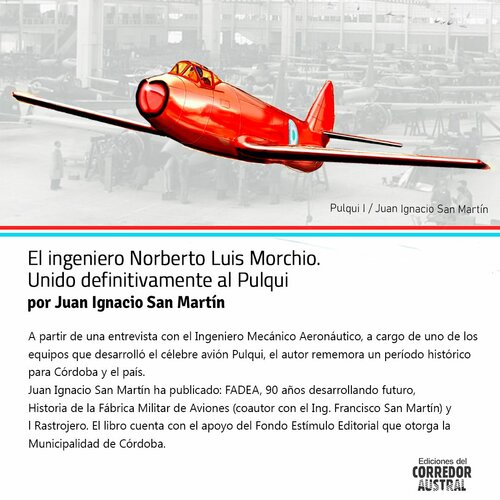
Log into Facebook
Log into Facebook to start sharing and connecting with your friends, family, and people you know.
 www.facebook.com
www.facebook.com
Erdosain
ACCESS: Secret
- Joined
- 10 March 2020
- Messages
- 476
- Reaction score
- 1,956

La “enciclopedia” del DINFIA Guaraní al IA-50 G-II - Gaceta Aeronautica
Australis | Núñez Padín acaba de publicar la monografía más extensa de su historia, dedicándole 100 páginas al “propjet cordobés” diseñado por Héctor Eduardo Ruiz. El autor de la obra explica cómo concretó un trabajo minucioso y comparte algunos anticipos de su contenido.
 www.gacetaeronautica.com
www.gacetaeronautica.com
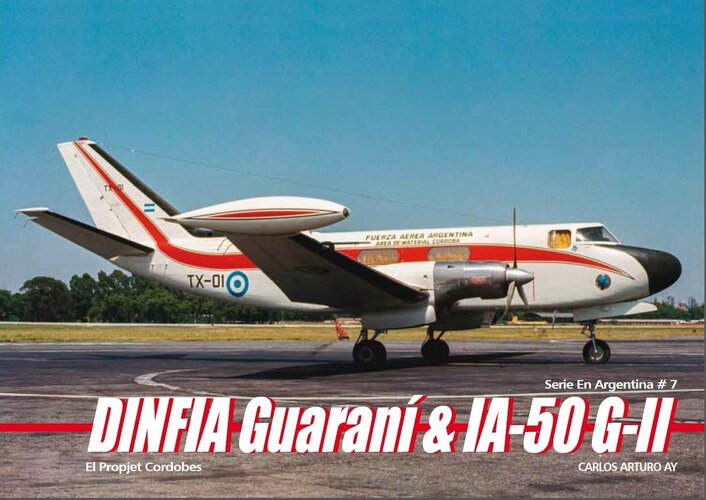
Erdosain
ACCESS: Secret
- Joined
- 10 March 2020
- Messages
- 476
- Reaction score
- 1,956
This new book, called "The engineer Norberto Luis Morchio, definitively united with Pulqui", rescues the figure of a true pioneer of the Argentine aeronautical industry, designer of the famous Pulqui jet plane, conceived and developed in 1946 at the Instituto Aerotécnico de Córdoba, under the direction of Commodore Juan Ignacio San Martín.
He was a member of the design team - along with his young colleagues Humberto Ricciardi and Enrique Cardeilhac - becoming a fundamental protagonist in the great history of the Argentine aeronautical industry.

 www.facebook.com
www.facebook.com


He was a member of the design team - along with his young colleagues Humberto Ricciardi and Enrique Cardeilhac - becoming a fundamental protagonist in the great history of the Argentine aeronautical industry.

Juan Ignacio San Martín
Juan Ignacio San Martín is on Facebook. Join Facebook to connect with Juan Ignacio San Martín and others you may know. Facebook gives people the power to share and makes the world more open and...
 www.facebook.com
www.facebook.com
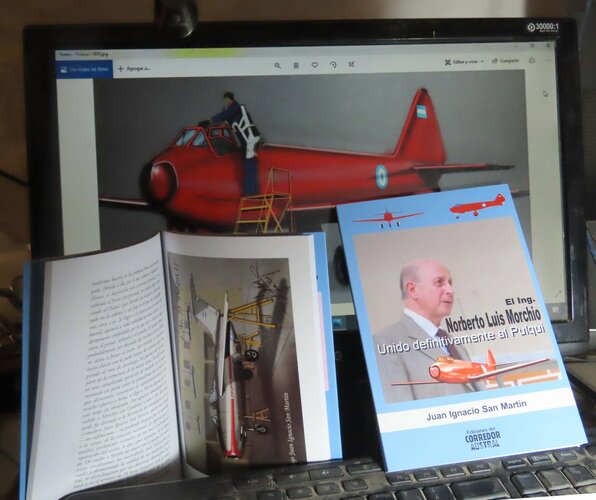
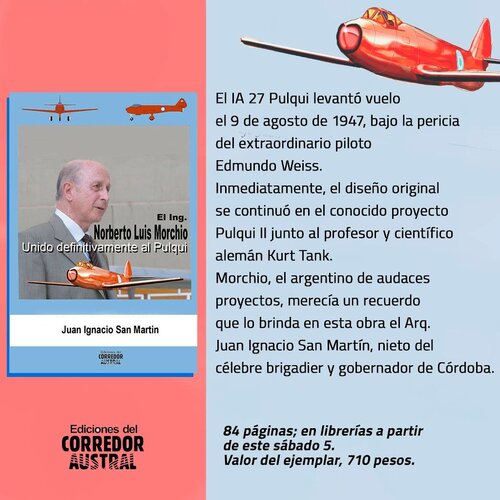
- Joined
- 26 May 2006
- Messages
- 34,828
- Reaction score
- 15,709
From Aerofan 2020.It is a shame that the Argentinean of the forum does not contribute anything, so...
Horten's first fighter proposal to Argentinian Air Force:
Attachments
Erdosain
ACCESS: Secret
- Joined
- 10 March 2020
- Messages
- 476
- Reaction score
- 1,956
I wonder why Argentina wasn't interested in the Messerschmitt-Helwan Ha300?
Was Argentina's aviation industry capable of producing foreign aircraft under license? I "fantasize" about Argentine-produced Macchi C 200 and C 202s.
Was Argentina's aviation industry capable of producing foreign aircraft under license? I "fantasize" about Argentine-produced Macchi C 200 and C 202s.
- Joined
- 3 September 2006
- Messages
- 1,474
- Reaction score
- 1,465
a- Because Argentina's choice of Nazis was the Horten brothers rather than Willy Messerschmitt?
b- Because the "Helwan" 300 originated in Spain, at Hispano Aviacion, so would smack too much of the former colonial power for the hyper-nationalistic Peronists?
b- Because the "Helwan" 300 originated in Spain, at Hispano Aviacion, so would smack too much of the former colonial power for the hyper-nationalistic Peronists?
COLDOWN
ACCESS: Secret
- Joined
- 12 November 2019
- Messages
- 241
- Reaction score
- 309
I don't think nationalism/facism is a thing here. Argentine fascism was more pragmatic, like the spanish one.
For example, the "Nahuel" Project from the "Revolución del 43" was cancelled by peronists when there were fireflies and shermans available for a cheap price and with the proven capabilities of these vehicles.
For example, the "Nahuel" Project from the "Revolución del 43" was cancelled by peronists when there were fireflies and shermans available for a cheap price and with the proven capabilities of these vehicles.
Dilandu
I'm dissatisfied, which means, I exist.
a- Because Argentina's choice of Nazis was the Horten brothers rather than Willy Messerschmitt?
Not exactly they have much to choose... The best German constructors found employment in USA and USSR. The second-best found new jobs in Germany. Argentina mostly get those, whose ideas was considered of low practical interest.
That really wouldn't explain the arrival of Kurt Tank and his team, + a lot of test pilots and engineers. Most impressively is the contract of a large amount of polish technicians, one of the best known being R. Dyrgalla (or Czekalski), who was behind the first Argentine Aerial missile, The Tabano, while Czekalski was behind the family of recoilless cannons that argentina produced and sold.a- Because Argentina's choice of Nazis was the Horten brothers rather than Willy Messerschmitt?
Not exactly they have much to choose... The best German constructors found employment in USA and USSR. The second-best found new jobs in Germany. Argentina mostly get those, whose ideas was considered of low practical interest.
Dilandu
I'm dissatisfied, which means, I exist.
. Most impressively is the contract of a large amount of polish technicians, one of the best known being R. Dyrgalla (or Czekalski), who was behind the first Argentine Aerial missile, The Tabano
Ironically, it seems that the Tabano project was dropped mainly because of over-expectations from German engineers...
But the Tabano wasn't made by them... nor related to them, was made mostly by polish technicians that previously worked on the Enzian while in the Uk, the whole reason it died its...a bit uncertain to be fair, it was a project so secret it only was made known by Dyrgalla's books (thing that kinda need to search for as there could be a lot we dont know), Things like political pressure, unsatisfactory results, or just an overall lack of aircraft that could carry it could have terminated the project. (remember that it was only tested on the Calquin).. Most impressively is the contract of a large amount of polish technicians, one of the best known being R. Dyrgalla (or Czekalski), who was behind the first Argentine Aerial missile, The Tabano
Ironically, it seems that the Tabano project was dropped mainly because of over-expectations from German engineers...
Dilandu
I'm dissatisfied, which means, I exist.
I wasn't clear enough; I meant, that the project was dropped because German engineers arrived, and Argentinean expected them to be much more competent than Dyrgalla. Apparently, they weren't, because the best they were able to suggest was the local production of German WW2-era rockets and missiles.But the Tabano wasn't made by them... nor related to them, was made mostly by polish technicians that previously worked on the Enzian while in the Uk, the whole reason it died its...a bit uncertain to be fair, it was a project so secret it only was made known by Dyrgalla's books (thing that kinda need to search for as there could be a lot we dont know), Things like political pressure, unsatisfactory results, or just an overall lack of aircraft that could carry it could have terminated the project. (remember that it was only tested on the Calquin).
- Joined
- 11 March 2012
- Messages
- 3,244
- Reaction score
- 3,171
The extended tail contains a Magnetic Anomaly Detector, which senses subtle changes in the earth's magnetic field caused by metal hulls of submarines.View attachment 660653
Concept art for the ASW version of the IA-50 Guarani II, note the extended tail and "Cheek" mounted gun pods.
The "Cheek" mounted gun pods are used to kill deck crew firing AAA at ASW airplanes.
But most germans engineers (like the polish ones) arrived in 1947, even Dyrgalla was contracted at the same time, much like the Tabano, other options were analyzed (like the V-1 and the PAT-1 guided bomb used from Lancasters) but those were purely german/Argentine driven projects, while the tabano was completely different, starting the project way earlier than the rest in 1947 and ending in the mid 50s, not by german pressure but regarding more aspects of its use (specially considering that the Calquin was...beginning to show age and there wasn't another aircraft that could carry it, Meteors couldn't do it, G.55s couldn't do it, it wouldn't make sense to have it on a bomber ether..).I wasn't clear enough; I meant, that the project was dropped because German engineers arrived, and Argentinean expected them to be much more competent than Dyrgalla. Apparently, they weren't, because the best they were able to suggest was the local production of German WW2-era rockets and missiles.But the Tabano wasn't made by them... nor related to them, was made mostly by polish technicians that previously worked on the Enzian while in the Uk, the whole reason it died its...a bit uncertain to be fair, it was a project so secret it only was made known by Dyrgalla's books (thing that kinda need to search for as there could be a lot we dont know), Things like political pressure, unsatisfactory results, or just an overall lack of aircraft that could carry it could have terminated the project. (remember that it was only tested on the Calquin).
It doesn't really make a lot of sense considering that the Tabano is inspired in a german project, and by the 50s it was being tested, with some success in San Jose de Las Salinas, and even repeating the tests several times, up to the point with live Warheads against aerial targets (claimed).
Erdosain
ACCESS: Secret
- Joined
- 10 March 2020
- Messages
- 476
- Reaction score
- 1,956

Desde el “ring side”: ¿Por qué fracasó el proyecto Guaraní? (1/2) - Gaceta Aeronautica
La historia del DINFIA IA-50 Guaraní contada "desde adentro" por unos de los testigo de la época.
 www.gacetaeronautica.com
www.gacetaeronautica.com

Desde el “ring side”: ¿Por qué fracasó el proyecto Guaraní? (2/2) - Gaceta Aeronautica
Méritos y los “palos en la rueda” que se interpusieron en el sendero del proyecto IA-50 Guaraní II.
 www.gacetaeronautica.com
www.gacetaeronautica.com
Two for the price of one!!
A simulator for the Oerlikon 20mm AA cannon

And a bit more interesting and (at least for me) fascinating, its this automated version of the same gun.

Argentina received a bit over 200 of this guns for free from Switzerland, all examples were brand new and their use can be seen a lot for training and on board some M113s for AA and support fire.
Seeing this demonstrator (along its fire director) its something that actually seems pretty straight forward, much like the Dardo II, a kit to convert something that on its own wouldn't perform efficiently on todays warfare into something that could offer a lot more. I really see a system like this with some changes (more ammo capacity and maybe a simpler platform for easier transport) as a decent Air Defense system at a really low cost.
A simulator for the Oerlikon 20mm AA cannon
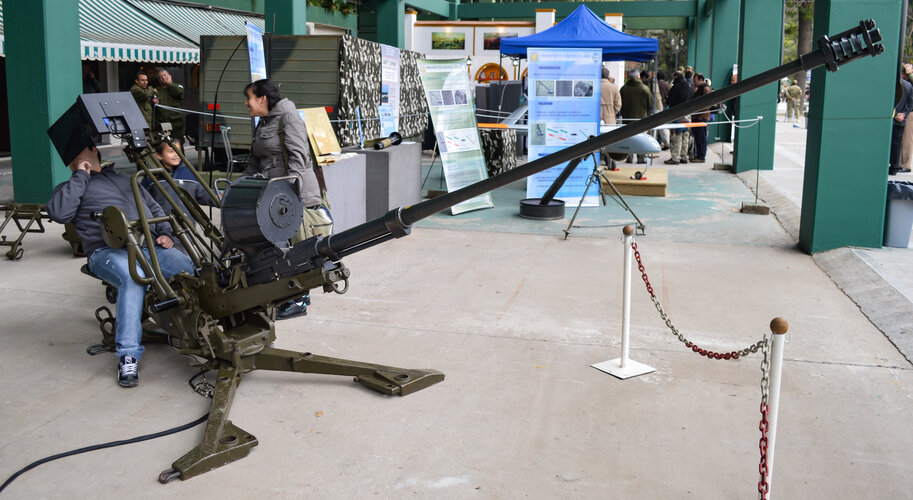
And a bit more interesting and (at least for me) fascinating, its this automated version of the same gun.
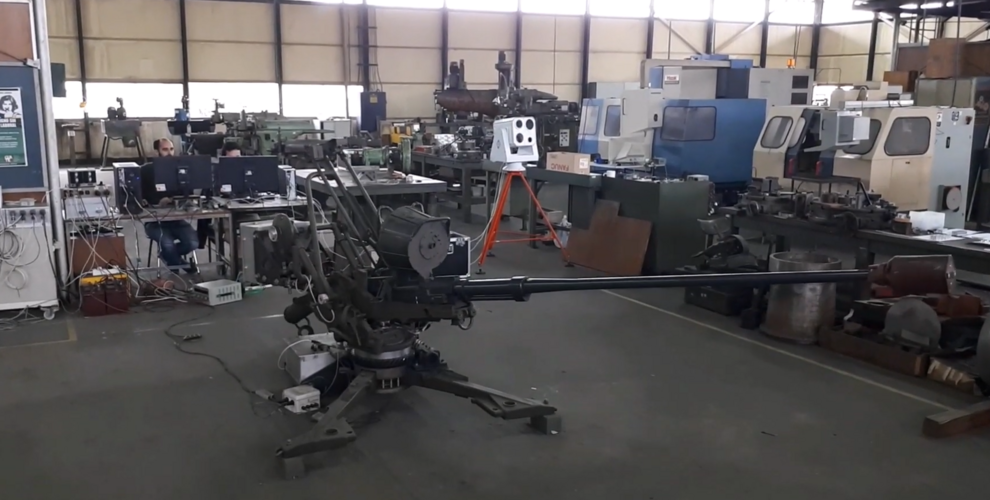
Argentina received a bit over 200 of this guns for free from Switzerland, all examples were brand new and their use can be seen a lot for training and on board some M113s for AA and support fire.
Seeing this demonstrator (along its fire director) its something that actually seems pretty straight forward, much like the Dardo II, a kit to convert something that on its own wouldn't perform efficiently on todays warfare into something that could offer a lot more. I really see a system like this with some changes (more ammo capacity and maybe a simpler platform for easier transport) as a decent Air Defense system at a really low cost.
Last edited:
Erdosain
ACCESS: Secret
- Joined
- 10 March 2020
- Messages
- 476
- Reaction score
- 1,956
Todo sobre la FMA
el Gaceta Aeronaútica hay un artículo sobre el Guaraní y se muestra una foto del Ing. Ruiz con una maqueta de una versión 19 plazas ( semipresurizada ?????? ) acá va el link : Desde el “ring side”: ¿Por qué fracasó el proyecto Guaraní? (2/2) - Gaceta Aeronautica (gacetaeronautica.com) alguien...
www.zona-militar.com
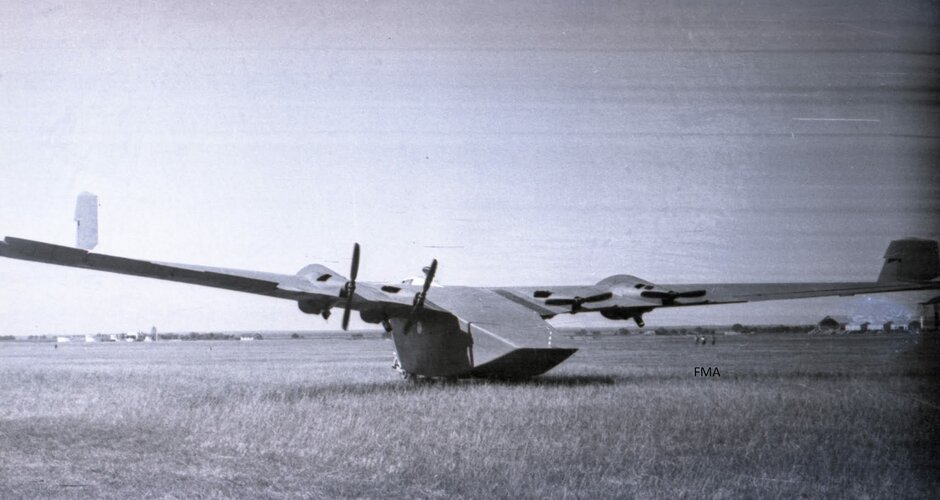
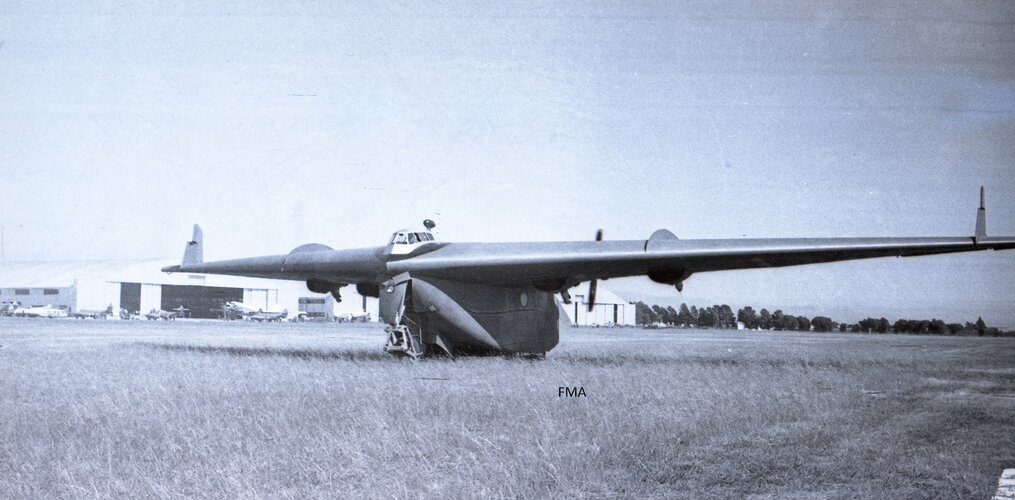
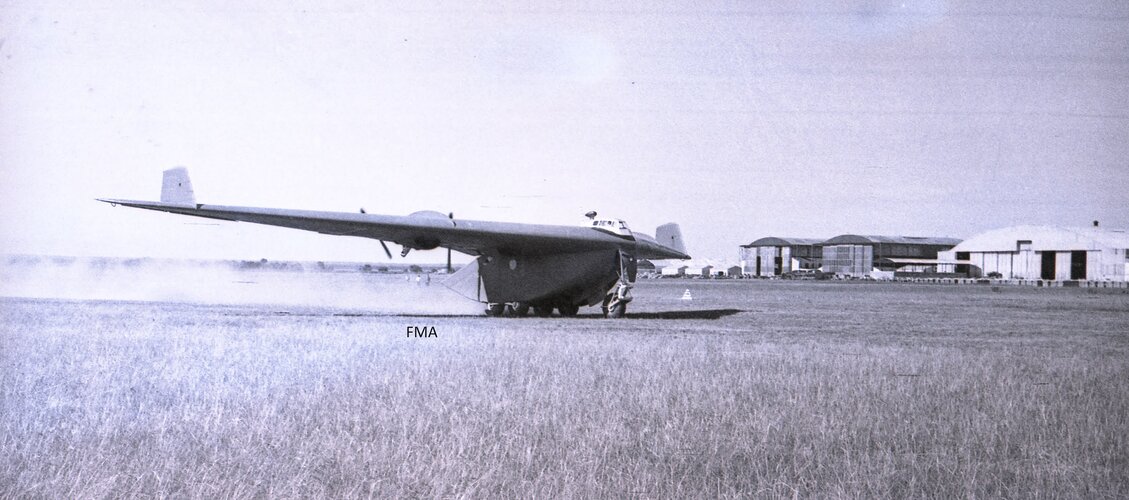
Similar threads
-
Argentine SAIA 90 fighter project
- Started by overscan (PaulMM)
- Replies: 24
-
-
-
AX-04: Last Torpedo Bomber development of the 20th Century?
- Started by Grey Havoc
- Replies: 14

